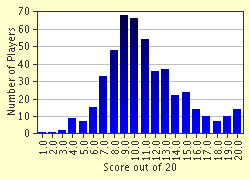Quiz Answer Key and Fun Facts
1. J.R.R. Tolkien is to Rings as William Golding is to:
2. Sherlock Holmes is to Watson as Hercule Poirot is to:
3. Charlotte Bronte is to Yorkshire as Thomas Hardy is to:
4. Karl Marx is to Highgate as Oscar Wilde is to:
5. Edgar Allan Poe is to Raven as Samuel Taylor Coleridge is to:
6. Count Vronsky is to Anna as Oliver Mellors is to:
7. 1973 is to Patrick White as 1976 is to:
8. Aunt Polly is to Tom as Aunt Polly is to:
9. Clarissa is to Epistolary as Ivanhoe is to:
10. Ernest Hemingway is to Rifle shot as Jack London is to:
11. King Hamlet is to Claudius as Duncan is to:
12. "Two Gentlemen of Verona" is to "Los dos hidalgos de Verona" as "All's Well that Ends Well" is to:
13. "The Da Vinci Code" is to Paris as "The Third Man" is to:
14. Edgar is to Mystery as Hugo is to:
15. Elizabeth Barrett is to Robert Browning as Sylvia Plath is to:
16. Hypochondriac is to Argan as Miser is to:
17. Ben Jonson is to Elizabethan as George Eliot is to:
18. Umberto Eco is to Italy as Georges Simenon is to:
19. David John Moore Cornwell is to John Le Carré as William Sydney Porter is to:
20. Emile Zola is to Naturalism as Albert Camus is to:
Source: Author
Arlesienne
This quiz was reviewed by FunTrivia editor
agony before going online.
Any errors found in FunTrivia content are routinely corrected through our feedback system.

